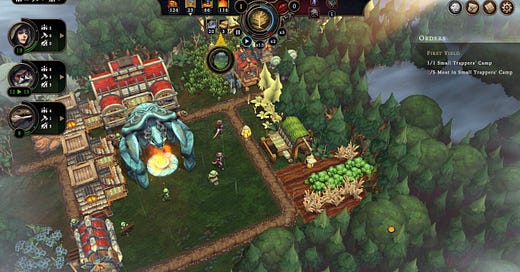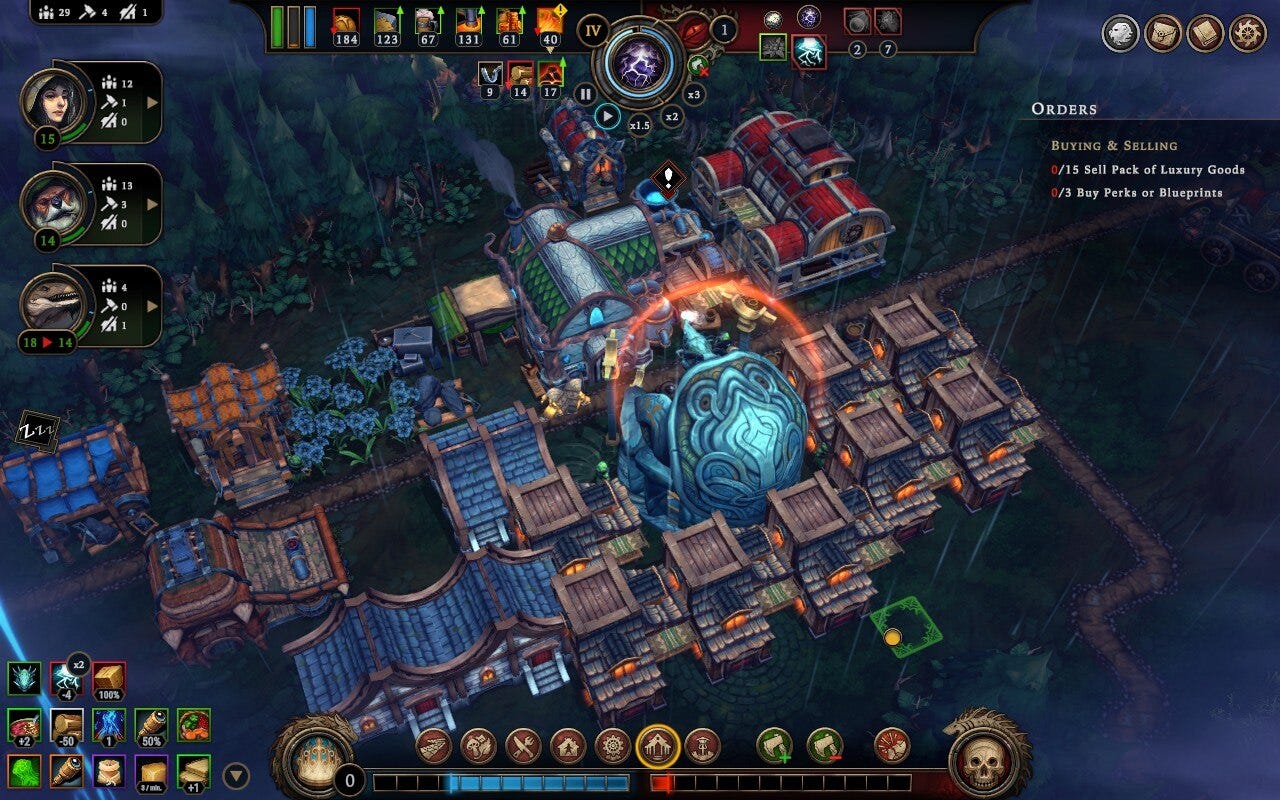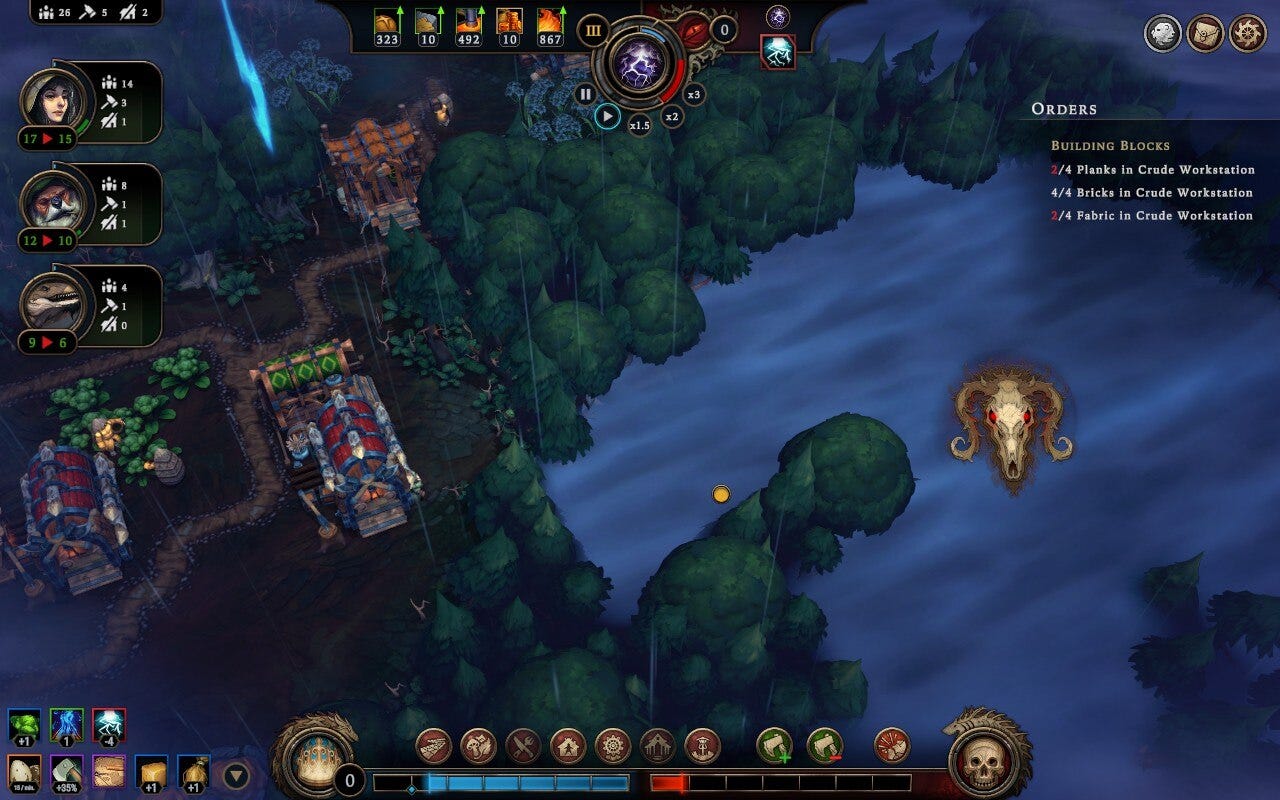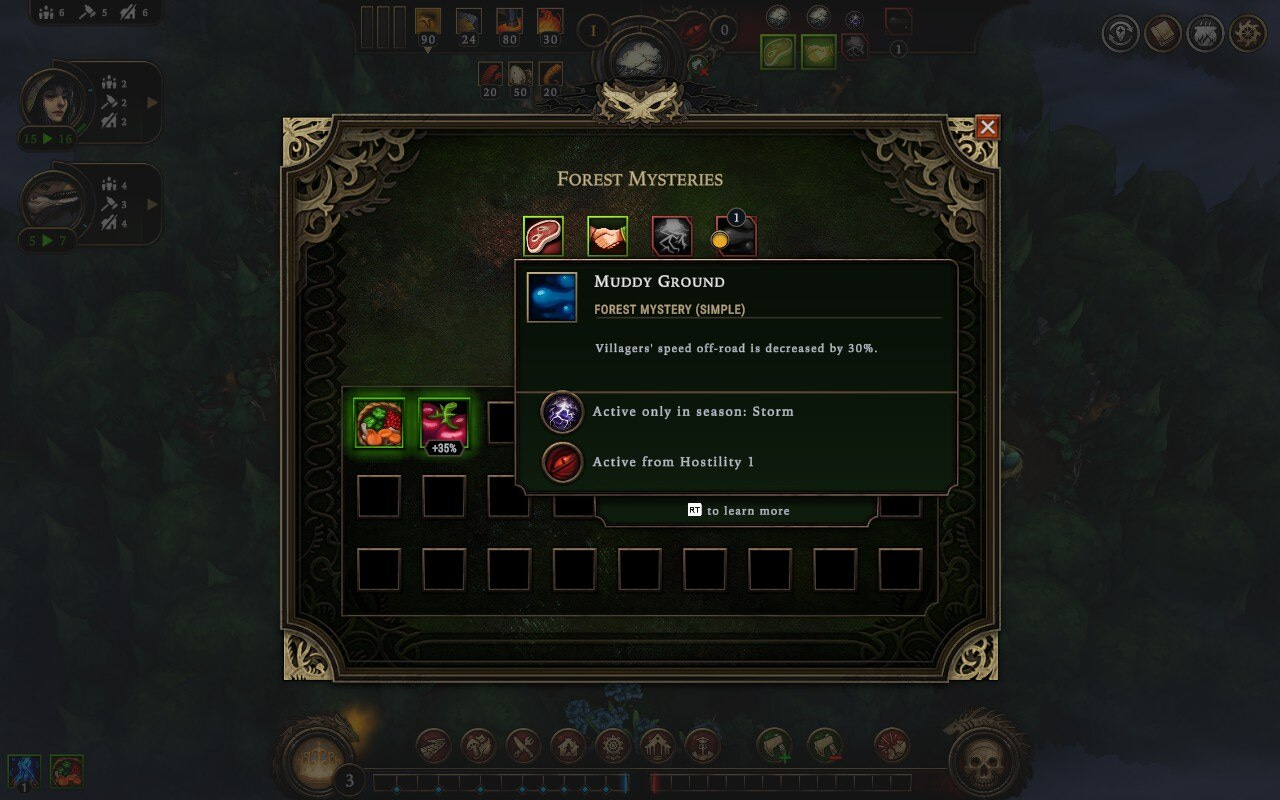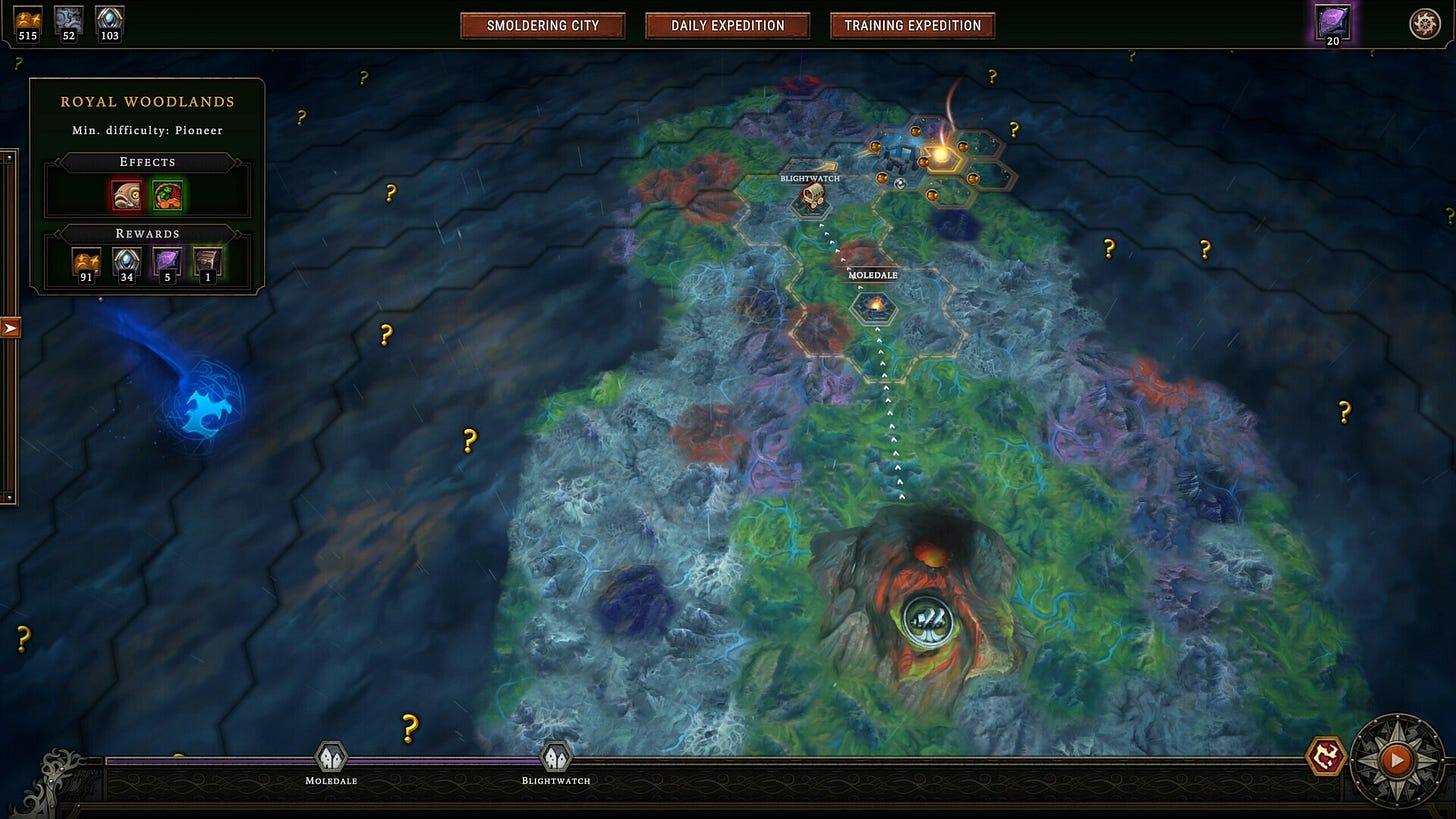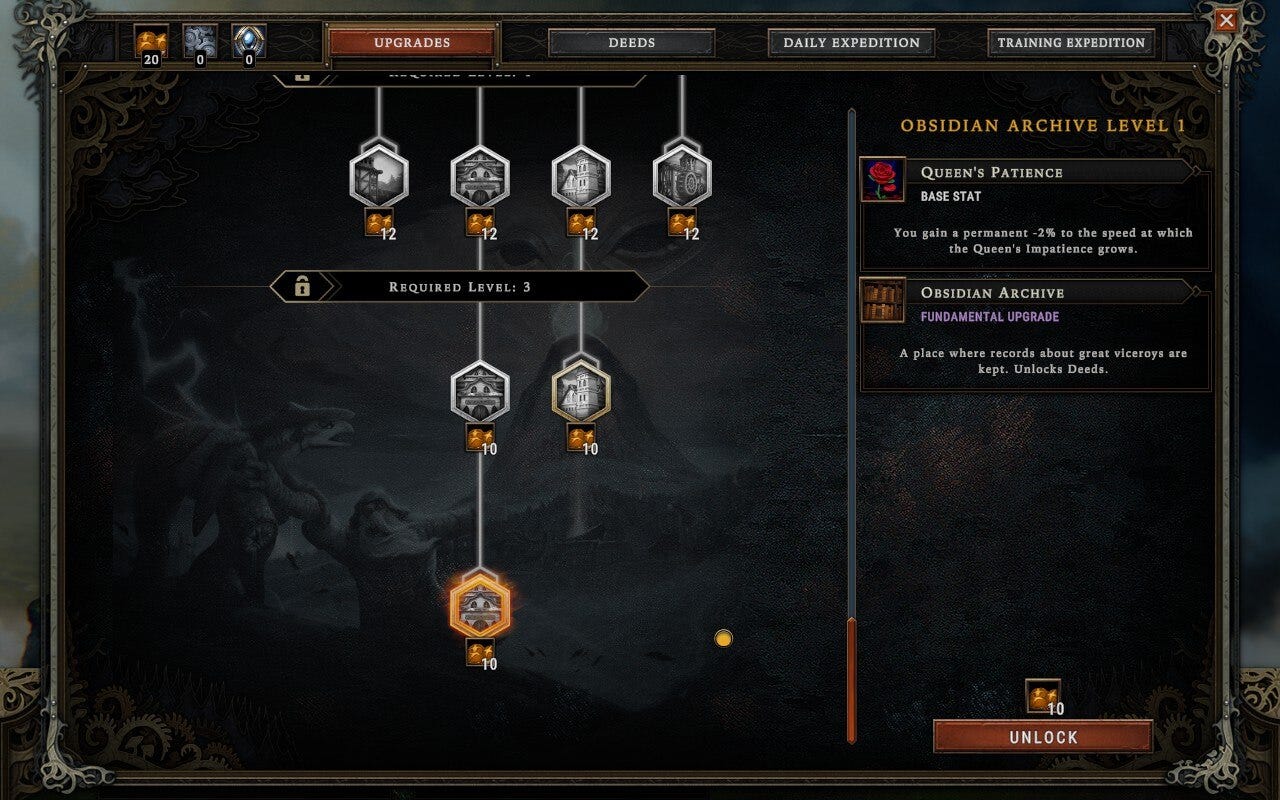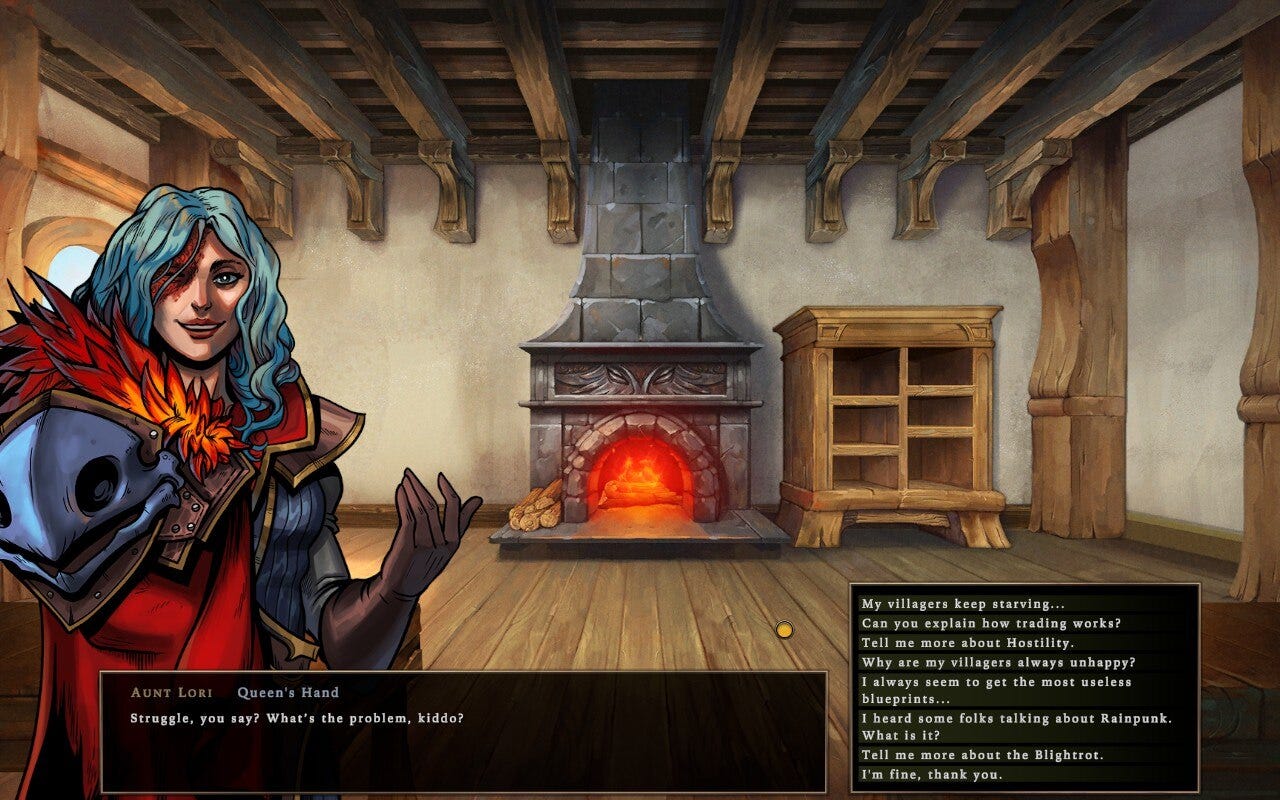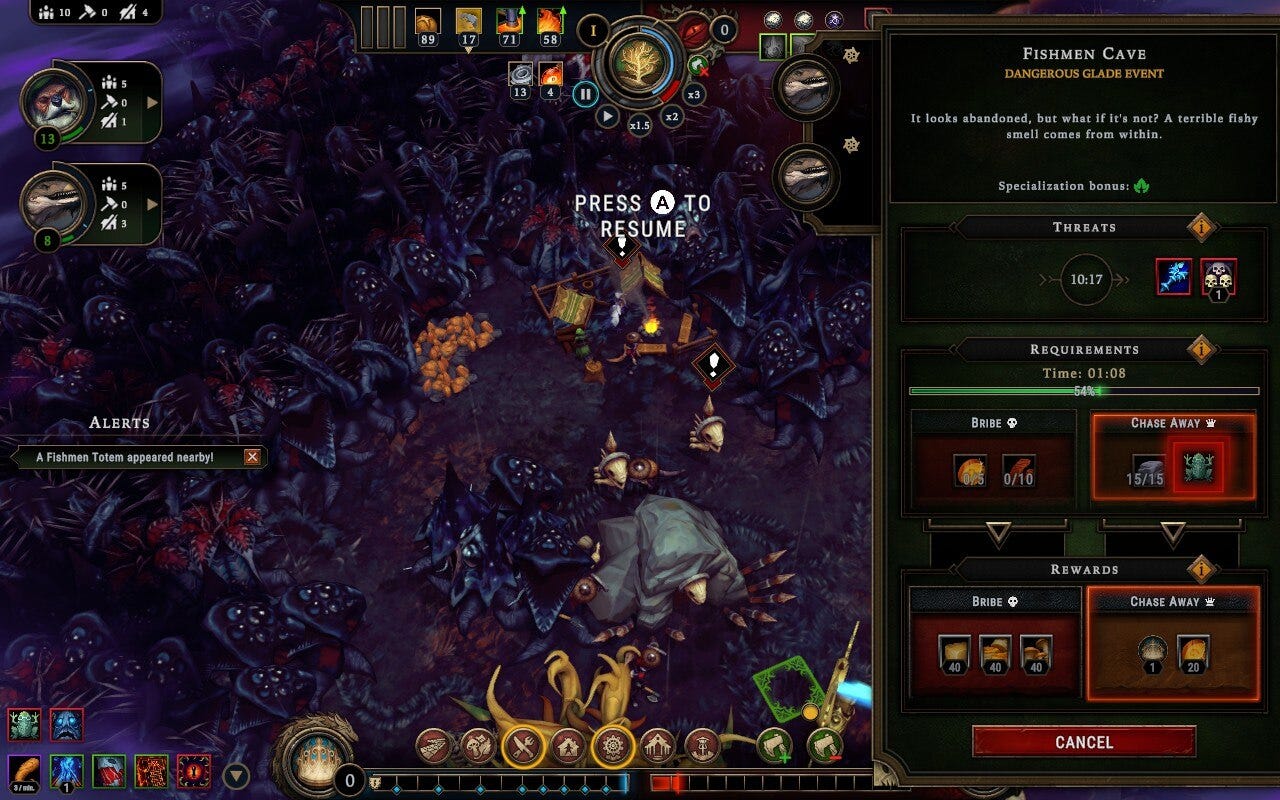PC, Steam Deck
$29.99
Endless
Against the Storm is a real time strategy game where you build settlements in a fantasy world wracked by apocalyptic storms. Your settlements are a means to an end, stops along your caravan’s journey to reaching Ancient Seals that, once repaired, will end the storms.
Unlike city builders like The Settlers and Age of Empires, Against the Storm lacks combat, focusing instead on literal environmental factors. Periodic storms make your villagers miserable; the forest’s “hostility” increases if you chop down too many trees; sometimes you’ll be in benign woodlands, other times you’ll hack your way through forests full of threats, forcing you to adapt your strategy each playthrough.
With every completed settlement you unlock persistent upgrades, buildings, and perks. When combined with the game’s larger goal of constructing chains of settlement into the increasingly perilous land around Ancient Seals, this combination of repetition and variation and incrementally-revealed game mechanics makes the game a roguelite – unusual for city builders. Even after a dozen hours of play, there are still major mechanics I haven’t yet encountered.
Every settlement begins in the same way: a few villagers in a glade with a warehouse and a large hearth. By constructing camps and workshops, your villagers can chop wood, gather food, mine stone, and process them into more complex goods and consumables by carrying them between buildings and warehouses. These satisfy your villagers’ needs and fulfil orders sent by your queen, both of which earn you reputation points.
As your reputation increases, you unlock new buildings; when your reputation is high enough, you win. This usually takes one to two hours, after which you return to the world map to place a new settlement a bit further along the way to an Ancient Seal. Of course, it’s not quite that easy. Settlements fail if the queen’s “impatience” rises too high. Impatience automatically ticks up over time and jumps when villagers leave because they’re unhappy or are killed.
New orders from the queen arrive every few minutes, like “Build two Woodcutters’ Camps and produce 10 Wood” for which you’ll be rewarded with three new villagers, reinforced axes, and one reputation point. Another might be “Keep your human villagers’ Resolve above 25 for 30 seconds”, which means making sure they’re well-fed, housed, and have some entertainment and culture available. Usually you can pick between a couple of options for each order depending on what you have on hand.
Villagers are specialised according to their species: beavers are faster at woodcutting and engineering but are harder to make happy, whereas lizards are better at tending animals. It’s pretty straightforward to make sure the right villagers are assigned to the right tasks.
You can direct your villagers to cut specific trees in order to reach clearings in the forest called Glades. Glades are shrouded in fog until you open a route but typically include supply caches plus a threat and/or opportunity that needs to be resolved quickly before it harms your settlement or disappears. One “glade event” threatened to kill three villagers every five minutes unless I delivered wood and fabric; another was a lucky stag that needed to be caught quickly. All the events include a choice in how you resolve them: you can break open a supply cache or send it back to the queen for extra reputation points.
Occasionally you get to pick new “cornerstones” (i.e. perks) for your settlement, like an Exploration Contract that gives you extra resources every time you open a new glade. In keeping with its roguelite nature, practically everything that happens in Against the Storm involves choices: when you unlock new buildings, you usually get to choose between two or three.
The best word to describe Against the Storm is “logistics” – half of my time was spent figuring out why my villagers weren’t making meat jerky fast enough.
Most goods that aren’t raw materials like wood and vegetables are made with “recipes”. For jerky, you combine insects or meat with a fuel like wood, oil, or coal. Insects and meat are easily obtained by villagers stationed in a Trapper’s Camp, which is pretty cheap to build; and wood comes from villagers working at a Woodcutters’ Camp.
So far, so good. But jerky can only be made in specialised buildings like a Kiln, Butcher, or Smokehouse. Constructing a Smokehouse requires 5 planks and 2 fabric, neither of which are raw materials; you can make both, at great expense, in a Crude Workstation, but you’re better off using specialised buildings like a Lumber Mill (built with 2 bricks and 2 fabric) or a Leatherworker (ditto). Where do bricks come from? Also a Crude Workstation, but also a Kiln. And so on.
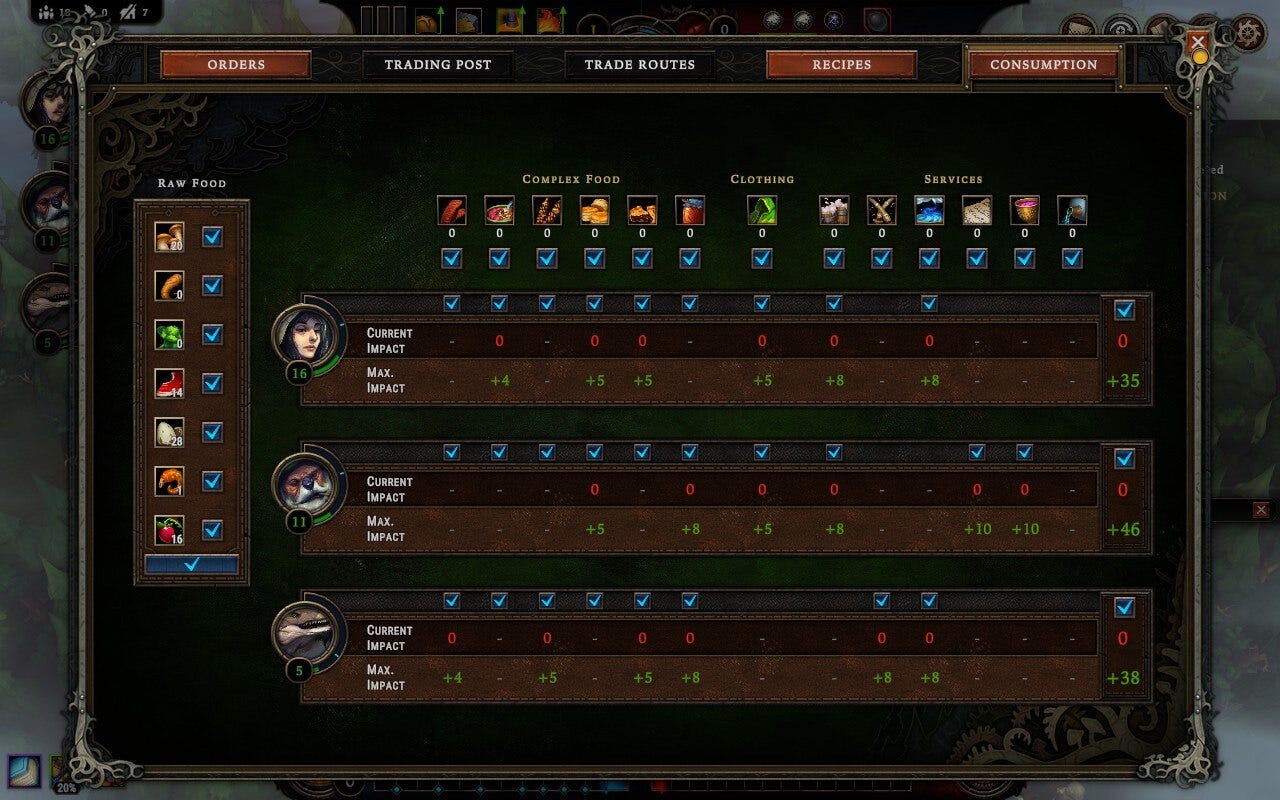
The supply chain is rendered transparently by villagers literally carrying supplies back and forth between forests and farms and camps and warehouses and workshops. When they’re not doing that, they’re working (with a little timer showing how far they’re along in making, e.g. planks); waiting for raw materials; walking to the hearth to get warm; or resting. Everything is based on units and timers; even entertainers’ output is measured in entertainment units per minute. It’s all highly deterministic
This better sound interesting to you, because everything in Against the Storm is about making processed goods. Villagers are much happier eating processed foods (“complex food”) like biscuits, jerky, and porridge, and glade events and orders invariably require delivery of luxury or trade goods that have lots of inputs. But there are always shortcuts; you can trade for resources you’re missing, and most inputs to a recipe can be swapped if you’re lacking in one or the other.
If I were a programmer, I’d say that my jerky production problem was a bug in my production line.
The game tries to make debugging easy. The UI highlights which of your supplies are increasing and decreasing, with special icons for ones that are plummeting. When you place a building, dotted lines connect it to other buildings that it’ll draw resources from, indicating you should place it in the midpoint. And when my second settlement came with the “muddy ground” condition that slowed my villagers down even more than usual when they weren’t on paths, not only did I start paying more attention to laying paths everywhere (the basic ones are free) but I began rotating my buildings so their entrances directly faced paths.
It’s an oddly generous game. Whenever a new order or event pops up, there’s no penalty to pausing the game to figure out how you’ll restructure your economy to produce 15 packs of building materials, nor is there anything stopping you from moving smaller campsites as often as you like when you encounter better resources on the map. Even bigger buildings can be dismantled and all your building materials refunded, though that takes a bit longer.
Then again, I suspect most players would abandon the game all too quickly without this leeway, given how frequently new constraints and objectives materialise. Every few minutes, the season changes from “drizzle” (spring/fall) to “clearance” (summer) to “storm” (winter), with major effects on everything. Farmers plough in storm, plant in drizzle, and harvest in clearance, but harvesting requires more effort, meaning you can scale back workers during the storm and drizzle. The storm makes villagers depressed to the point where they start leaving and the queen’s impatience begins rising.
One solution is to sacrifice resources in the hearth to boost morale. This is so ruinously expensive I was anxiously watching my wood stockpile to see if I could make it through the storm, which explains why I was relieved to discover I could upgrade my hearth by placing housing and decorations around it. Yet more systems!
Against the Storm cleverly addresses the criticism of city builders being thinly-disguised celebrations of capitalism and imperialism with those same systems. Not only are settlements subject to unavoidable storms but the ferocity of those storms is based on the forest’s “Hostility”. Many factors influence Hostility, but the most interesting ones flow from the expansion of your settlement.
The more glades you open, the more woodcutters you have, the more trees you fell, the worse things get, so while it’s possible to clearcut the forest and create sprawling town, the resulting Hostility would be enormous. The game’s systems and objectives instead guide you toward more strategic ends: felling the fewest trees possible to reach glades; avoiding overproduction; reducing workers at camps and deactivating them entirely if necessary; and surging villagers for urgent events. Normal city builders reward you for reaching population and revenue milestones, but you’ll only ever have a handful of villagers in Against the Storm, scurrying back and forth your gradually-migrating buildings.
The end result is a game that places the merciless logic of production in an environmentally conscious world. No small feat!
The world map lets you choose new settlement locations, which have to be near existing ones. Your goal is to reach and repair far-off Seals before a Blightstorm wipes everything out; Blightstorms happen every few decades, so if you take too many seasons to complete each settlement, you won’t reach it in time. Once a Seal is repaired, the interval between Blightstorms extends, giving you more time to reach ever more distant Seals.
Every location has a semi-random set of modifiers, usually related to its location. My first settlement had Settler’s Luck (each settler has a 35% chance of not eating food during a break) and Gift of the Woodlands (trees produce more wood when felled). Other modifiers included Lightweight Wood (woodcutters carry 10 more goods in drizzle season), Looming Darkness (villagers are unhappier) and Humid Climate (they’re more annoyed).
The roguelite of it all extends to the Deeds and Upgrades systems. Deeds are achievements earned by, say, winning a settlement in under five years, or winning without completing any orders. These unlock new buildings and experience points, which in turn level you up, unlocking yet more buildings, traders, and cornerstones. Upgrades are bought with resources earned on completing settlements, incrementally reducing the difficulty (e.g. villagers walk 2% faster, the hearth uses 2% less fuel, etc.). All these unlocks persist even beyond Blightstorms.
Oh, and you have a home where you can talk to your Aunt about the backstory and rules, because why not?
My first few settlements took around 1-2 hours to win. I’m sure speedrunners can get through far quicker, but new orders and their reputation points only become available at fixed times. You can get points through glade events, but it takes a while to chop down the trees to reach them; so does ramping up your production lines to produce the goods required to make your villagers happy and earn reputation that way.
I got stuck trying to repair a Seal, though. The Seal was hidden in a forest with mutated, hard-to-chop trees, beset by dreadful storms, like a plague of mosquitoes that temporarily halved production. Unlike previous settlements where reputation points were the route to victory, this could only be won by locating which glade the seal was in (other glades had monuments pointing in its direction), then repairing it over four stages.
Most glades triggered a threat upon entry; one had a Fishmen Cave that needed pacifying lest it kill my villagers every dozen minutes. Of course, this process also produced more threats – Fishmen Totems – that increased Hostility. I had to divert a whole bunch of villagers and resources away from normal production to sort things out.
The narrative structure of these “Seal Repair” missions (Seal Team Sicks?) gets shakier when it comes to the Ancient Seal itself. I had to apply four separate Seal Fragments, each of which required delivering a bunch of resources (e.g. 125 wood) or, say, repairing a building. I can see why you need to fulfil your queen’s orders with packs of crops, but what does that have to do with applying a Seal?
Since this was my first time playing, I felt especially disheartened at the onslaught of requirements. I was asked to establish five trade routes, which wasn’t even possible since I didn’t have the relevant Upgrade, or find four ancient tablets, and I kept coming up short in glade after glade. I won’t lie: I just gave up after a couple of hours.
Aside from Seal missions, Against the Storm is very chill. There are no enemies laying waste to your buildings, and on easy difficulties you’ll have plenty of time to address even the most dangerous threats. It’s basically a little worker placement village simulator with just the right amount of structure and time pressure to give it momentum. Any less and it’d be a toy; and more and it’d be stressful.
On a micro level, it’s addictive to see so many numbers go up every second, inching towards fulfilling an order or repairing a building. On a macro level, it’s just as addictive to trek towards new seals and unlock upgrades. It’s so addictive that, like Civilization, I simply have to delete this game. That means I won’t ever reach major gameplay mechanics like blightrot that infects your settlements, or “rainpunk” technology that can power advanced machinery, or trade routes. Sadly I know myself too well to risk spending more time in the game.
Yet I can’t fault it for that. Against the Storm is more honest and affordable than the countless mobile strategy games that bleed players’ wallets dry. Even though I don’t plan to play more, I keep thinking about how I might do better next time. Perhaps I’d focus on villagers’ happiness and complex foods, or I’d tackle more settlements before trying to repair the Seal, or I’d try building multiple Trading Posts, or…
Against the Storm lets you speed up time. But not by enough.
The game has an official wiki: more developers and publishers should do this! Also, I occasionally struggled because some interface elements were hard to make out on Steam Deck. This is mostly my fault: like most strategy games, it’d be twice as easy playing on a big monitor with a mouse, the way it was clearly designed for and how most players will experience it.

